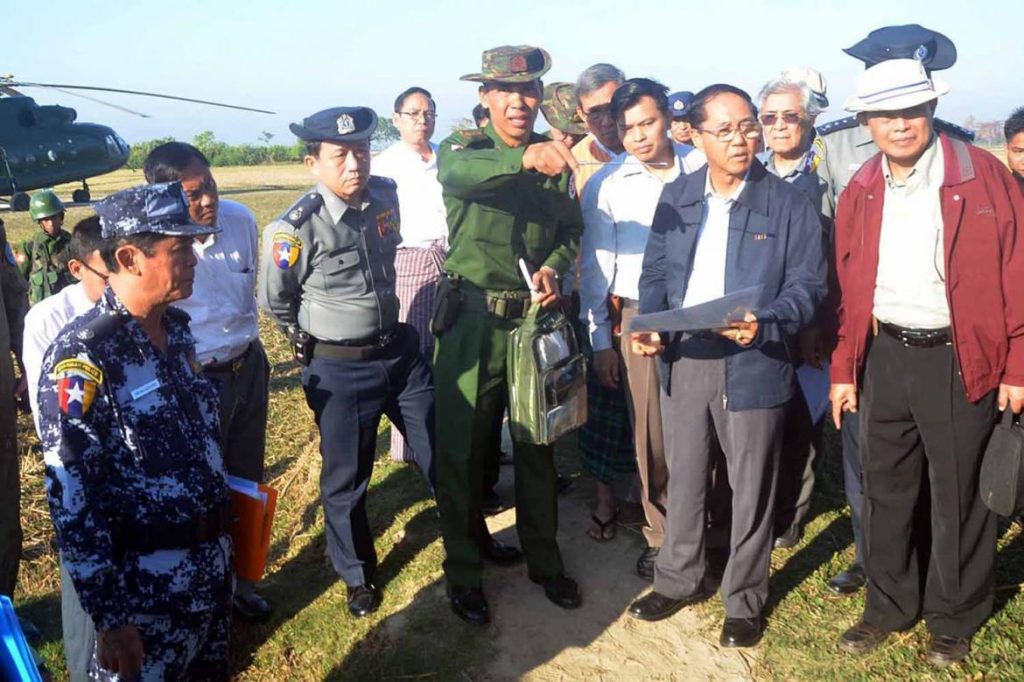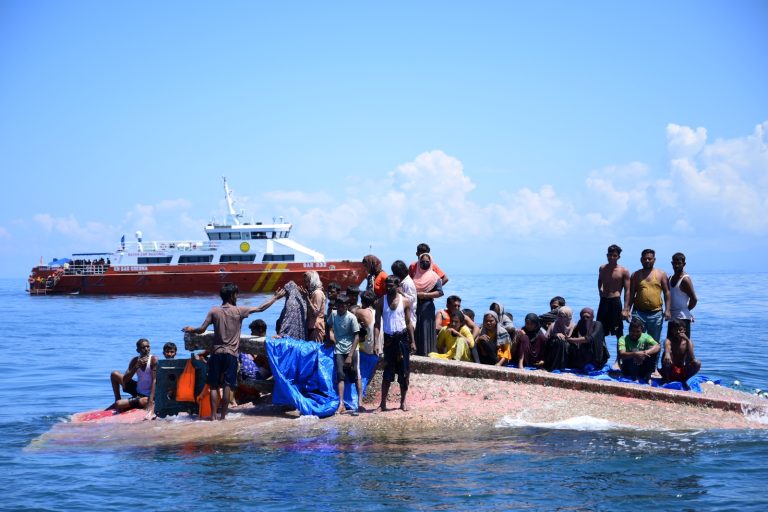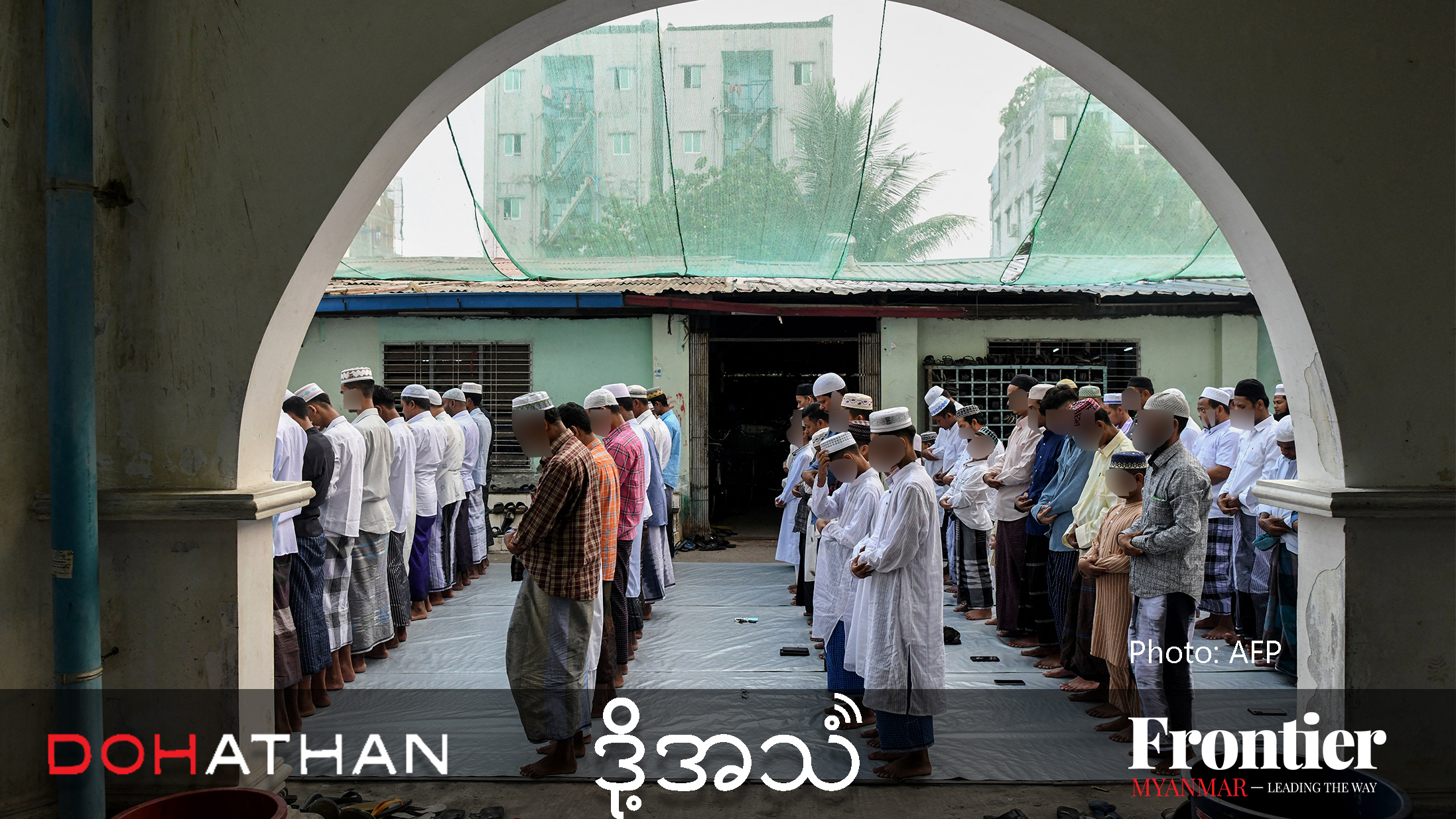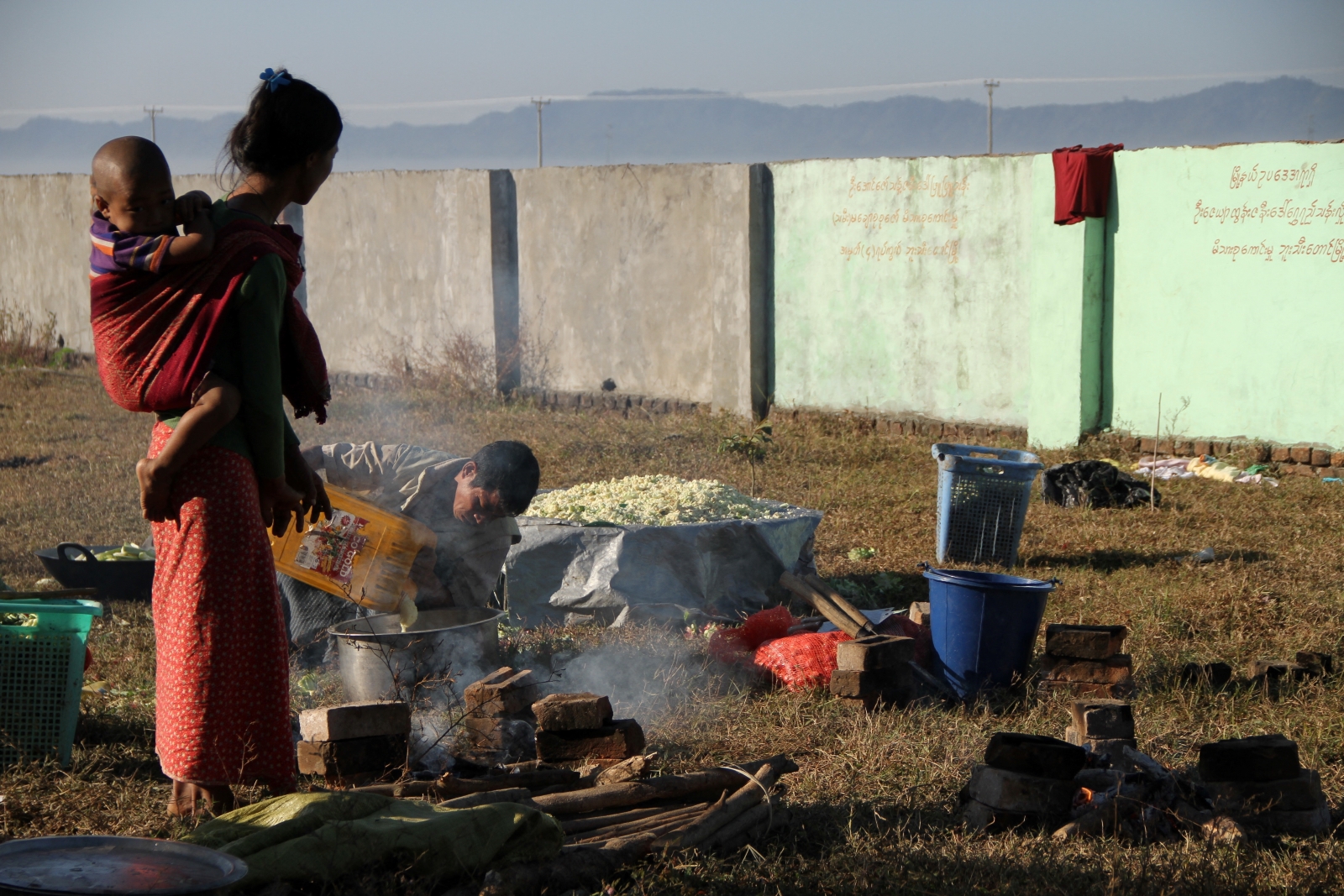The government’s blanket rejection of abuse allegations in Maungdaw and refusal to conduct a serious investigation may be popular in Myanmar, but will make it harder to address the issues underpinning the insurgency.
By OLIVER SLOW | FRONTIER
JANUARY 9 marked three months since coordinated attacks were launched on police outposts in northern Rakhine State, leading to a heavy security crackdown, a block on humanitarian aid and a shift in the dynamics of what was already an incredibly complex issue.
In the months since the military “clearance operations” began in response to the attacks, security forces have killed an estimated 100 suspected attackers and arrested another 600, according to state media. Some have since been released and others sentenced, but no details of their charges, sentences or trials have been made public.
At the same time, about a dozen security forces have been killed by the militant group, which has been named as Harakah al-Yaqin (Faith Movement). Meanwhile, almost all humanitarian aid has been cut off to an already vulnerable population – about 150,000 people in the area were regular recipients of United Nations assistance.
Hundreds, possibly thousands, of properties have been burned to the ground and the UN says 34,000 Muslims, most of whom self-identify as Rohingya, have fled across the border into Bangladesh.
Support more independent journalism like this. Sign up to be a Frontier member.
A number of those fleeing into Bangladesh have accused military personnel of using disproportionate force during their operations, including mass rape, arbitrary arrests, burning of homes and villages, and extra-judicial killings. The government and military have consistently denied all charges.
Daw Aye Aye Soe, spokesperson for Myanmar’s Ministry of Foreign Affairs, which is headed by Daw Aung San Suu Kyi, told IRIN in December that the security operation had been conducted “with very much restraint” and that “regarding rape, ethnic cleansing – it’s completely false.” She also questioned the number of people reported to have fled to Bangladesh, saying a figure of 20,000 or 30,000 is “blown out of proportion”.
But the government has come under significant pressure to allow independent observers into the region. In December, representatives from 13 private and state media organisations were given limited access to the affected area on a government-sponsored trip. Despite repeated requests, Frontier was refused permission to participate.
On December 23, two days after speaking with reporters who were part of the trip, the decapitated body of a Muslim man, U Shu Na Myar, was found near his home.
Just hours after his body was found, and before any suspects had been reported arrested, the Facebook page of the State Counsellor’s office, which is also headed by Aung San Suu Kyi, published a post with the headline “Truth teller beheaded” in English.
An accompanying article written in Myanmar said the man had “told media there was no case of arson by the military and police forces, no rape and no unjust arrests”.
This blanket denial of any wrongdoing by authorities has been typical of the approach taken by the military and the government since the security operations began.
It may well have been the case that Shu Na Myar was killed by the militants. But as Frontier has consistently stated in recent months, such vigorous denials do no one any favours; they only heap more suspicion on the security response and create further divisions in an already volatile region.
If there really has been no wrongdoing by the security forces then the government must allow an independent and credible investigation committee (and the committee formed in December and headed by vice president U Myint Swe is nothing of the sort) to look into the facts on the ground.
The blanket denial approach has been discredited by the emergence on December 31 of a video showing police abusing Muslim villagers. Shot on November 5 in Kotankauk village in Maungdaw, the video shows why the government should respond to abuse allegations seriously, rather than questioning the motives of those making the complaints, or those publishing them.
Local opinion
The government’s response to the October 9 attacks may have attracted criticism abroad, but at home its approach is supported overwhelmingly. Much of the Myanmar population believes that the security forces have committed no wrongdoing.
Any accusations of human rights abuses are regarded as lies made either by the international media or the Rohingya to elicit public sympathy for their plight.
The international media in particular has attracted the scorn of the Myanmar public and authorities. One opinion piece in state-controlled media accused international media of working “hand in glove” with the attackers, a frankly absurd accusation.
There has, however, been some sloppy reporting from some international outlets, most notably the story published by the UK’s Daily Mail in December about a video purporting to show a young Rohingya boy being tasered by a Tatmadaw soldier. The report was incorrect and the incident had in fact taken place in Cambodia.
Some said the report was proof that the international media was deliberately manipulating the situation to portray Myanmar in a negative light, but anyone who is familiar with the Daily Mail’s editorial values will no doubt be aware that it was just another example of the publication failing to adhere to the most basic journalistic principles.
At the same time, some have used doctored images to try and build support for the Rohingya cause. On January 3, the Global New Light of Myanmar carried a front-page article headlined “Fabricated stories, misleading pictures about Rakhine cause global criticism”.
It included five photos that it said were being incorrectly captioned and shared on social media “in an attempt to cause misunderstandings about Myanmar”. This has in fact done the cause a disservice, as it encourages sceptics to dismiss credible reports in mainstream media out of hand as pro-Rohingya propaganda.
In private conversations, Myanmar friends have told me that they view the international coverage of the issue as a deliberate attack on the country’s reputation. It is nothing of the sort. What is being questioned is the official narrative from an institution – that is, the Tatmadaw – that has a well-established track record of carrying out human rights abuses against ethnic minorities (as well as the majority Bamar) for many years.
As the International Crisis Group report, Myanmar: A New Muslim Insurgency in Rakhine State, noted, the clearance operations in northern Rakhine State appear to employ methods “akin to [the Tatmadaw’s] standard counter-insurgency ‘four cuts’ strategy developed in the 1960s to cut off rebel forces from their four main support sources” – namely food, funds, intelligence and recruits.
The tactic, the report said, involves cordoning off territory for concentrated operations, a “calculated policy of terror” to force populations to move, destruction of villages in sensitive areas, and the confiscation and destruction of food stocks that might support insurgents.
There is no conspiracy in the international media and no deliberate attempt to make Myanmar “look bad”. Many of the journalists questioning the government’s narrative have a deep fondness for the country, as do I. But that does not mean the claims from the government or the military should be accepted on face value, as the incontrovertible truth.
Questioning the official line
So why is the military’s version of events accepted by so much of the Myanmar public without question? After all, there remains a deeply held distrust of the military as a result of its decades of economic mismanagement and repressive rule.
A major reason is the support of Aung San Suu Kyi. The State Counsellor maintains significant domestic popularity and her apparent acceptance of the military’s narrative has given it much greater credibility.
While she has said very little about the situation in Rakhine State, on the rare occasions that she has publicly discussed it her language has been pro-military and dismissive of international “meddling” in Myanmar’s internal affairs. For those who held her in such high regard as a defender of human rights, it has been a disappointing response.
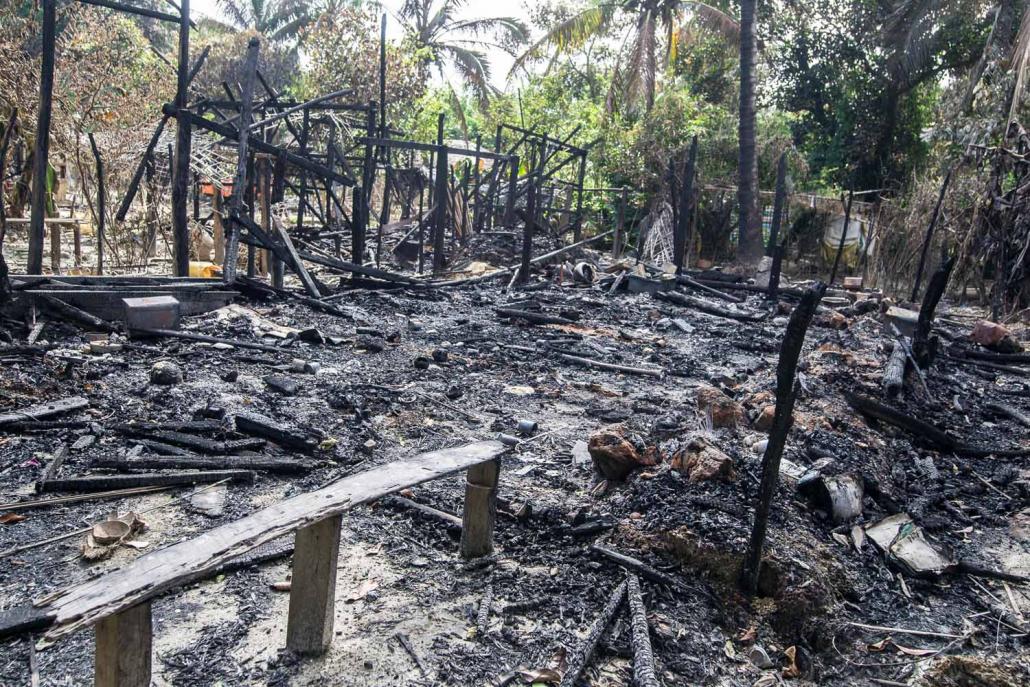
A burned home in a Muslim village in Maungdaw. The government has rejected allegations that the military is responsible for the destruction of up to 1,500 buildings. (Teza Hlaing / Frontier)
But as Aung San Suu Kyi has pointed out herself, she is a politician, not a human rights defender, and this forms another part of the reason she is not speaking out. There is of course the issue that the military still wields significant power, and to criticise it would put serious strains on an already fraught relationship. But it is also important to note that those who identify as Rohingya are generally disliked within the country.
As has been well documented, the Rohingya term is rejected by much of the population, who regard them as “Bengali” immigrants from Bangladesh. To be perceived as speaking out in defence of the Rohingya would potentially lose her party significant political support. More nationalistic parties – most notably the Union Solidarity and Development Party and the Arakan National Party – would be quick to exploit these perceptions.
There is the third theory, though: that, like much of the population, she simply does not believe that the accusations being made are true.
Another reason for the widespread support of the security operation is that the October 9 attacks are regarded as an attack on the country’s sovereignty by a “foreign” force. We saw a similar sentiment in February 2015 when the Myanmar National Democratic Alliance Army, a Kokang armed group, attacked military outposts in the north of the country.
While an official ethnic group, the Kokang are closely related to Han Chinese (some would say they are Han Chinese), and the offensive was launched from Chinese territory. Unsurprisingly, it was regarded as an attack by a foreign force on the country’s sovereignty – a view that the Tatmadaw encouraged – and support for the military spiked as a result.
Rape accusations
Human rights groups and international media outlets have reported accusations of rape being conducted by Tatmadaw soldiers on Rohingya women fleeing the violence. The government has vehemently dismissed these allegations.
In fact, minutes after the December 23 post on the State Counsellor’s page about the decapitated Muslim man in Rakhine State, a new post was published accusing Rohingya women of fabricating stories of rape. The post was published under the headline “fake rape”.
Dozens, perhaps hundreds, of women have made the accusations and they should not be dismissed so flippantly by the government, especially given the Tatmadaw’s track record.
In 2014, the Women’s League of Burma released a report saying that more than 100 women and girls have been raped by Myanmar’s military since the 2010 election. “Due to restrictions on human rights documentation, WLB believes there are only a fraction of the actual abuses taking place,” the group said in a statement.
The report added that majority of the cases were reported in ethnic minority areas. For many years, civil society groups, particularly those operating in ethnic minority areas, have published reports of Tatmadaw soldiers raping women.
In 2011, Aung San Suu Kyi herself said that rape was being used as a tool of war in Myanmar. In a video for the Nobel Women’s Initiative, she said: “Rape is used in my country as a weapon against those who only want to live in peace, who only want to assert their basic human rights. It is used as a weapon by armed forces to intimidate the ethnic nationalities and to divide our country. This is how I see it. Every case of rape divides our country.”
Despite this, the rape accusations are now dismissed out of hand. In November, a Rakhine parliamentarian told the BBC that Myanmar soldiers couldn’t have possible raped Rohingya women because “they are very dirty” and have a “low standard of living”.
It is a viewpoint that has seeped into the public conscious too. In private conversations I have heard it uttered that the Rohingya women are “not attractive” and therefore would not be raped. Apart from being ugly language, it also ignores the fact that rape is more often about showing power over a particular person, or group of people, than sexual attraction.
There is no doubting that the situation in Rakhine State is incredibly complex, and the local Rakhine population understandably feel some fear about the new insurgency there. But progress needs to be made, and blanket denials do not help. A serious plan needs to be put in place to start to build trust between communities there again.
Top photo: A military official, centre, briefs Vice President U Myint Swe, head of the Rakhine State Investigation Commission, during his visit to Gwazon, a Muslim village in Maungdaw Township, on December 12. (State Counsellor’s Office / AFP)


